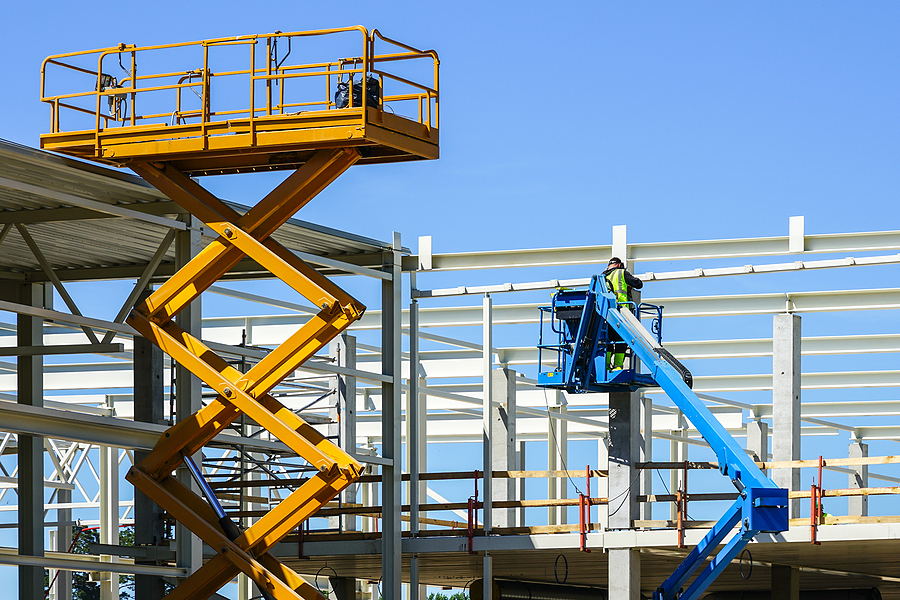Scissor Lift Safety Training and OSHA Regulations

Construction, retail, entertainment, and manufacturing all employ scissor lifts, which are movable scaffold work platforms with built-in supports allowing workers to move vertically and to different positions. Lifting mechanisms are distinct between scissor and aerial lifts because the scissor-like mechanism pushes the work platform straight up and down. Even though scissor lifts pose the same dangers as scaffolding when stretched and immovable, safe use of scissor lifts requires careful consideration of the lift's capabilities, limits, and safe procedures.
The following OSHA requirements (29 CFR) must be followed by employers to safeguard employees from the dangers of scissor lifts.
General Industry
- A system of scaffolds and ropes for descending from a height
- 28(b)(12) - Fall and falling object protection must be provided.
- 29(b) (Note) – Criteria and methods for fall prevention systems and protection from falling objects
Shipyards
- Staging or Scaffolding-1915.71
Construction
- 20(b) - Responsibilities for preventing accidents
- Safety training and instruction are mandated under 1926.21 of the Code
- Requirements for general use in 1926.451
- Mobile scaffolds are subject to additional restrictions under the 1926.452(w) section.
- 454 – Requirements for education and training
OSHA's Scaffolding regulation will apply to your scissor lift in many cases. Scaffolding-related eTools and resources are available from OSHA.
Manufacturing, purchasing, and operating scissor lifts are subject to ANSI requirements. For example, they may be found in the ANSI A92.3-2006 (Manually Propelled Elevating Air Platforms) and A92.6-2006 standards (Self-Propelled Elevating Work Platforms).
Employers must do a thorough risk assessment of the work location to pick the best equipment for the job. Scissor lift users must assess and apply controls that address fall protection, stability, and placement to ensure a safe work environment. Individuals who have been taught the proper usage of scissor lifts are only authorized to operate them. Employers must ensure that those workers demonstrate their ability to utilize a scissor lift. Strict compliance with manufacturer specifications, worker education, required personal protective equipment (PPE), and safe work practices are all part of a scissor lift operator's responsibility for safe operation.
The guardrails must be erected to prevent employees from falling from scissor lifts (see 29 CFR 1926.451(g) or 29 CFR 1910.29) (b). A guardrail system on a scaffold must meet the criteria and practice standards of 29 CFR part 1926, Subpart L or 29 CFR 1915.73.
Employers should teach their employees how to:
- Before using the scissor lift, check to determine if a guardrail system has been installed.
- Never, ever stand on the guardrails or the work platform.
- Avoid leaning away from the scissor lift by keeping your work within easy reach.
To avoid accidents, employers should make sure that the scissor lifts they use are safe and sturdy. Scissor lift use requires several safe work practices, such as:
- Lifts can't be moved in an elevated position unless the manufacturer's instructions are followed.
- The scissor lift should be isolated, or traffic control measures implemented to prevent other equipment from coming into touch with it.
- Work in areas that are stable and free of dangers that might lead to instability (e.g., drop-offs, holes, slopes, bumps, ground obstructions, or debris).
- Outside, only use the scissor lift if the weather is conducive.
- When using scissor lifts outside, they are often restricted to less than 28 miles per hour wind speeds.
Scissor Lift Hazards - Tip Overs Scissor Lift Hazards - Tip Overs
Scissor Lift Hazards - Equipment Collapse
- Scissor lift collapses are uncommon, but they can be avoided if employers take the following precautions:
- To prevent a collapse, it is essential to keep the safety mechanisms in place that are meant to avoid it.
- Never allow the platform's weight to exceed the load rating specified by the manufacturer.
- The scissor mechanism should always be utilized to elevate the work platform (e.g., using a forklift to lift the work platform).
- Ensure that the lift does not contact other moving machinery on the construction site.
- The safe operation of a scissor lift requires careful positioning of the machine to minimize crushing or electrocution threats.
Crushing hazards are present in workplaces using scissor lifts and may expose workers nearby, even those not working on the scissor lift.
Scissor lifts, like other types of mobile equipment, provide crushing dangers on construction sites. It is imperative that employers teach their employees to remain alert when:
- A scissor lift in motion passes by a stationary item.
- The scissor lift and a moving truck are in proximity.
- A fixed item, such as a door frame or a support beam, is passed under the scissor lift.
Using a scissor lift near electrified power lines necessitates careful positioning of the equipment to avoid electrocution, arc flash, and thermal burns. Electrocution can occur even if neither the scissor lift nor the worker comes into contact with the power line due to the possibility of an arc or a jump from the power line to the device.
The following work practices ensure that scissor lifts are safely positioned:
- To keep other employees and cars from getting too close to the scissor lift, set up traffic control measures around it.
- When operating or transporting the scissor lift about the workplace, make sure you use ground guides.
Locate work areas at least ten feet away from electrical power sources (such as power lines and transformers) that do not present any additional dangers from above (e.g., other utilities, branches, overhangs, etc.). The employer must verify that the worker is competent and has obtained the necessary electrical training if the job entails working near an electrical source. The [29 CFR 1910.269, 29 CFR 1910.333, and 29 CFR 1926 Subpart V] regulations Workers must be educated about working with or near scissor lifts. In accordance with [29 CFR 1926], .454] At the very least, training should include:
- Vertical and horizontal operation of the scissor lift using the manufacturer's instructions.
- A guide on using and safely storing things on a scissor lift, with information on weight restrictions.
- Another danger for employees using a scissor lift is falling from the platform (e.g., contact with electrical wires).
